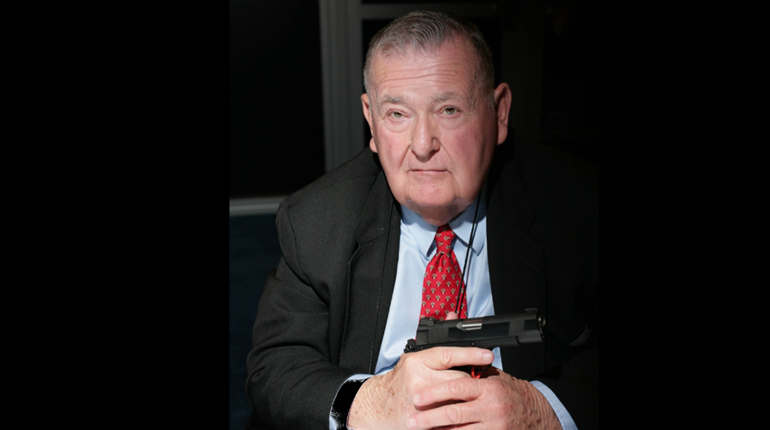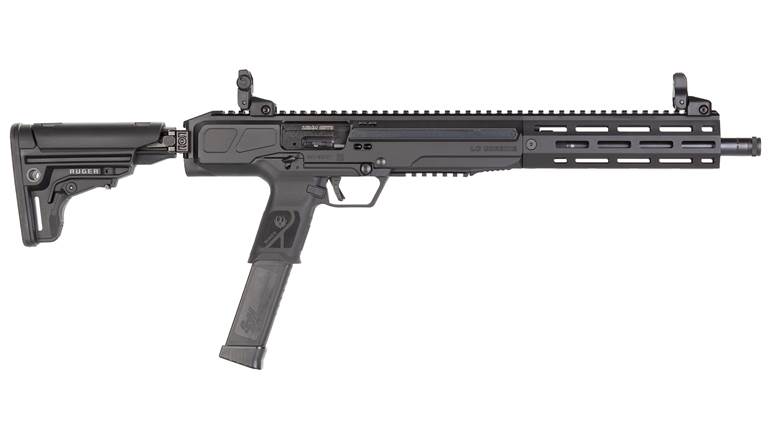
8/22/2012
When the late Bill Ruger first stamped his name on a firearm and offered it for sale, it was an innovation. That was right after World War II, and shooters wanted new guns. Ruger filled the demand for a .22 plinker with the Standard Auto, a gun that ended up in the hands of a national champion. Through the years, Sturm, Ruger & Co. continued to fill conventional needs with unconventionally made guns of nearly every imaginable type. The company that bears the iconic Ruger name and stylized eagle emblem follows that proven formula—the best of modern innovative gunmaking to produce guns for ordinary purposes. The two Ruger guns under consideration are perfect examples of that trend. They are both .22 Long Rifle handguns, one a revolver and one a semi-automatic. The revolver is the LCR-22, and the pistol is the SR22. Both guns are of typical Ruger quality and well-suited for .22 rimfire uses short of formal competition. Let’s start with the wheelgun first.
The LCR-22 is a continuation of a model that was introduced a couple of years ago. The first LCRs were in .38 Spl., followed closely by a .357 Mag. version. As noted, the LCR-22 is an eight-shot .22 Long Rifle revolver that is made in the same way as its center-fire progenitors—a process sufficiently unique as to warrant attention. Ruger’s LCRs are made with three different major assembly groups joined with interlocking surfaces, slots, lugs and screws. The butt section is made of rubber by Hogue, complete with finger grooves and cobblestone surface. Forward of that, there is a polymer frame section housing much of the action. This portion is connected to a cast aluminum alloy assembly that contains the cylinder and barrel, both of which are steel.
It is an unconventional firearm in appearance, but look closely and all that we are accustomed to seeing is still there. The system is an internal hammer, double-action-only revolver with a swing-out cylinder and thumb latch on the left side. Pressure on the trigger turns the eight-shot cylinder, which indexes with the barrel, raises the hammer and then releases it to fire. The LCR-22 is a handy little trainer, plinker or trail gun—but it is only half of the new Ruger .22 story.
There is also a brand new semi-automatic .22 Long Rifle pistol, and it has 10-plus-one capacity. At 4.90-inches high by 6.40-inch long, the SR22 is a handy size. Ruger built its business and reputation with the grand old Standard Auto, and it was the first and only gun for a fledgling Yankee gunmaker in the late 1940s. As .22s go, it is a tough act to follow, and the SR22 has no direct lineage or part interchangeability with that gun. Once again, Ruger engineers incorporated advanced materials and designed a completely new model. Some of what they used may have been learned in the development of the SR series of center-fire pistols, but this is really a fundamentally new gun. It is a medium-size pistol with good ergonomics and light weight, just 17½ ounces. Despite the trim dimensions, it includes a 10-shot magazine, double-action/single-action trigger and a rear sight adjustable for both windage and elevation. There are the almost-inevitable white dots in the sighting system, and I hope that Ruger will offer the plain black option. Considering that this little pistol sells for less than $400, you get a good bit for your money.
Made with a polymer receiver, aluminum slide and steel barrel, the SR22 is a straight-blowback pistol, although its operation is a bit unconventional. With the SR22, the shooter begins with an empty pistol, manual safety engaged and slide locked to the rear. He or she inserts a full magazine, pulls the slide all the way back and releases to close the slide and chamber a round. That clears the passive magazine safety, but the active manual safety has disconnected the trigger from the sear and related parts.
Mounted on the frame just above the left thumb, the safety lever is mirrored on the right side of the gun. By the way, so is the magazine catch. To fire, the shooter thumbs the safety/decocker up, which re-establishes the trigger linkage for a first shot in the double-action mode and displays a field of red. Subsequent shots are in single-action mode. When he has no further need to shoot, the shooter thumbs the safety/decocker down, displaying a field of black and dropping the hammer. Properly understood and operated, this system works perfectly. There are, however, a number of pistols that require opposite movements of the lever to put the safety off and on, so some of us may have to re-train ourselves.
To get a better idea of how the new guns perform, we took them to the range for a morning shoot. Let’s look at the LCR revolver first. It is designed to be completely safe in its handling and evolved from defensive caliber guns, where utter reliability is a necessity. Much of the role of the LCR-22 is as a trainer for the .38 Spl./.357 Mag., so it is designed to replicate handling the center-fire versions. The LCR trigger pull—on any model or caliber—is rather long, but decently smooth. Some observers have described it better than that, but I feel the weakness—if any—in the system is the forward movement to reset. It has at least three separate clicks as it sweeps forward and any one of them is capable of tricking you into thinking that the forward stroke is done. There is nothing that you can do because there is really nothing wrong, except that you have to learn another way to run a revolver.
Over the sandbags with some pretty good ammunition, I was able to get groups as small as 2.24 inches at 25 yards, but the norm was in excess of 3 inches. Since most of the ammunition fired was capable of groups close to a half-inch, it is probably a combination of operator error, the short sight radius and the heavy double-action-only trigger. It is also true that in a gun that light, the maker has to use a powerful mainspring to ensure that ignition is positive.
The SR22 is a completely different kind of gun. Styling is particularly modernistic, as has been the case with so many of the company’s latest pistols. It has recessed and grooved bars molded into the side and front of the polymer butt and chevrons across its rear. Some of what appear to be cosmetics are really functional touches—the angled surface across the topmost edge of the magazine floorplate, for example. It permits enough purchase to remove a recalcitrant magazine. I really like the deep pocket for the web of the hand. Combined with a high undercut under the trigger guard, it allows a positive grasp that is great for trigger control. Ruger even provides a dust cover light rail for those who prefer to mount a light or laser.
Range work with the SR22 was a little more rewarding. I had one group going that looked like it was going to break 2 inches, but it didn’t quite happen. Accuracy was notably better than the revolver’s, which was almost certainly a function of the SR22’s single-action trigger. That potential for hitting at range widens the scope of possible roles for the SR22 over the LCR-22. I noted that my sample pistol wanted to group far left. On this gun, a windage-adjustable rear sight lets you bring the group over to the center of the bull. Ensure that your range kit contains a really small, flat-bladed screwdriver to get that done. Also, check the performance tabulation with this story and note the range of velocities obtained with the new Ruger SR22. It used to be that .22 Long Rifle semi-automatic pistols were picky about functioning with such diverse bullet speeds, but this one worked to perfection with everything I tried.
The two Ruger handguns are completely different models, made to sell at affordable prices. While the LCR-22 offers the weight and versatility desired by outdoorsmen, and the SR22’s accuracy and capacity make it ideal for plinking, the dollar value is very high on both.
They remind me of when I was in high school, looking at those little advertisements in the back pages of American Rifleman that showed a nifty .22 auto for $37.50—from a new outfit called Ruger.





































